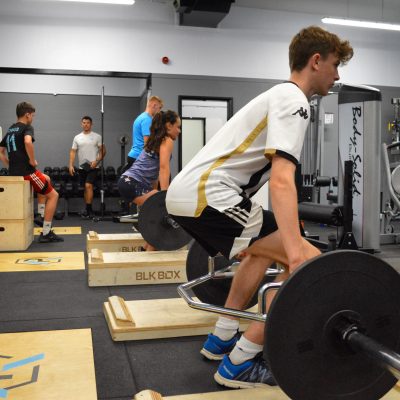Before goals can be reached, personal bests achieved or medals won, there has to be foundations set, based around hard work and a consistency of training. However, does high quality training have to be complex? Or is it simply a meticulous effort to master fundamental human movement and apply progressive principles within strength and conditioning?
Figure 1. One of our trainers helping teach the squat.
At the Advance Performance Lab we lay these foundations by challenging and exposing the athlete to the fundamental movements required to improve overall athleticism. The larger an athlete’s movement vocabulary the more equipped they will be to cope with the demands of the chaotic environment that is sport. Laying these basic foundations in preparation for more specific strength and conditioning later in the athletes development is key to long term success. At the Advance Performance Lab we lay these foundations by challenging and exposing the athlete to the fundamental movements required to improve overall athleticism. The larger an athlete’s movement vocabulary the more equipped they will be to cope with the demands of the chaotic environment that is sport. Laying these basic foundations in preparation for more specific strength and conditioning later in the athletes development is key to long term success.
The fundamental movements have been described as the abilities to squat, lunge, hinge, pull, push, press, brace, rotate, jump, land and sprint. The athlete should be allowed opportunities to practice these in a variety of different environments, directions and speeds. For example, there are occasions in which we allow athletes to practice skills in a closed environment with the coach setting specific constraints regarding a given skill to drive a specific outcome (i.e. a pre planned 90º change of direction at a cone, executed on the coaches command). Additionally, we create scenarios where skills are able to be practiced in a more open/fun/game style environment that allow for individual interpretation, visual perception and reaction time (Sprinting and changing direction to avoid being tagged; hinging/squatting to help a partner off the floor, grappling with an opponent to avoid being pushed/pulled, jumping and hopping as part of a group game).
Figure 2. Discussion promoting an athlete centre aproach and accountability.
Once we are happy that an athlete has reached a level of competency performing the fundamental movements, they are ready to move into a more specific, periodised, strength and conditioning programme based on their individual needs and the demands of their sport. Here we are focused on building strong, skilled, robust athletes which should in turn, decrease the likelihood of injury. We do this by exposing the athlete to some form of progressive overload of these fundamental skills. Some of the ways we may choose to overload an exercise may be time, volume and amplitude. However it could also include loaded resistance exercises such as squats, deadlifts, various forms of pressing and pulling movements like rows and pull-ups. This progression will normally coincide with an increase in training age, skill and confidence.
Figure 3. Supporting during the bench press.
This is not a quick process though and may take several years to reach this point, hence the phrase ‘long term’ athletic development (LTAD). Developing effective communication and a level of trust with the athlete is key to our athlete centred approach, and allows us to develop greater levels of buy in from each athlete.
Take away messages:
– Learn the fundamentals and perform them ruthlessly well.
– Consistency of training is one of the most important factors in athletic development.
– Allow athletes to have ownership and accountability, training shouldn’t only be driven by the coach.
If you have any further questions feel free to get in contact and send us an email, Talent@advancesport.co.uk
Many thanks
The Advance Team





